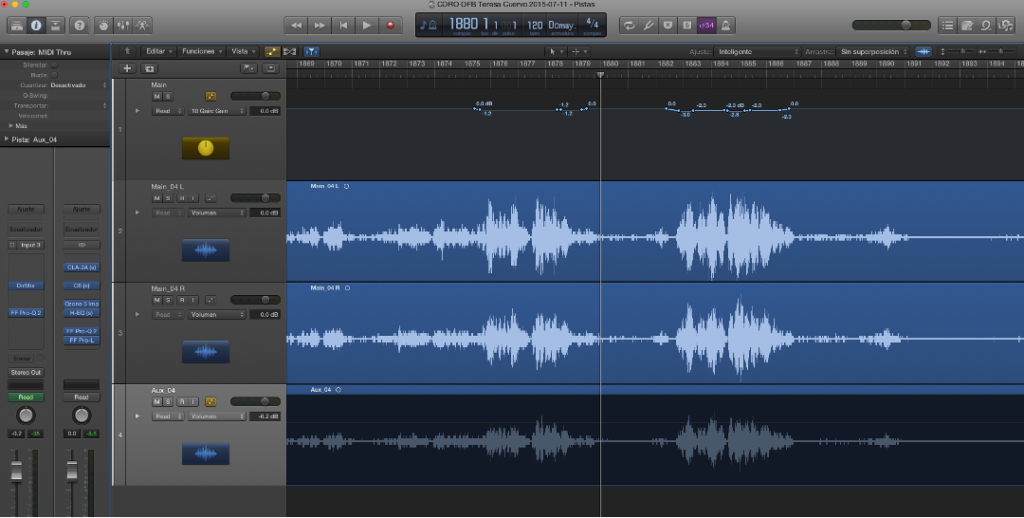[Download Multi-track for FREE]
By Cesar Arevalo | Audio Specialist.
For several years, the Philharmonic Orchestra of Bogotá has been giving regular concerts of its chamber groups, youth ensembles, and other ensembles that stand out for their talent and quality of interpretation. The city’s Philharmonic Choir, founded in the 1990s by the music master Carmiña Gallo, is not far behind with its staging of Latin American works and many other international origins.
With the participation of between 30 and 50 interpreters professionally dedicated to lyrical singing, the director Diana Carolina Cifuentes assembles an exquisite repertoire worthy of great national and international festivals and from which we have produced some of her most outstanding staging.
This time the presentation takes place in the Teresa Cuervo auditorium of the National Museum of Colombia, a relatively small space, with slightly bright acoustics due to the rock walls that line the main stage. The stage’s history dates back to its original design in the mid-19th century.
The repertoire includes music from the Latin American repertoire such as “Pueblito Viejo” by José A. Morales, “El Guayaboso” by G. López-Gavilán; as well as international music such as Keith Hampton’s “Pray his Holy Name” and various pieces of sacred music.

Image 1. Philharmonic Choir of Bogotá.
The recording
A simple AB spaced pair supported in the center by a Marshall MXL 990, the separation of both microphones in their omnidirectional mode is approximately one meter, located about 2 meters high. Although the living room has smooth walls and a wooden floor, this day the capacity was full, reducing the natural brightness of the room a bit.
Noise treatment
The microphones in the main array (AKG P420) were treated with Waves’ Z-noise to reduce a little noise caused by electrical connections that due to their age affects various equipment and lighting systems in the room, on the other side from the stage there is a machine room whose noises are perceived in the softest passages of the music.

Image 2. Treatment of continuous noise with Waves Z-Noise.
Treatment of the stereo image
This microphone array has been supported in the low range with Waves ‘RBass, a general equalization curve executed with FabFilter EQ2, supported with Waves’ H-EQ to manipulate certain frequencies in the stereophonic field, the iZotope’s Imager was used to open the low-frequency range a bit, as well as the higher frequencies to slightly expand the perception of the apparent width of the choir, and thus improve the characteristics of this small auditorium. This arrangement of microphones was also supported by Nomad Factory’s AS-Exciter, a very useful plug-in to enhance the brightness of the voice in this case the protagonist.

Image 3. Treatment of the main microphone array.
A reverb with a “decay” larger than one second to support the acoustics of the auditorium, was equalized to highlight the frequencies between 3 and 5 kHz a bit and subtly reduce the midrange that in this auditorium can make the spatial perception of the room sound a bit “boxy”. This auxiliary channel has been supported in the high range with iZotope’s Harmonic Exciter (“Warm” Algorithm) and also the stereo image has been opened up a bit in the ranges below 300 Hz and above 3 kHz in order to expand the spatial perception of the recording.

Image 4. Treatment of reverberation.
The center microphone (MXL 990) has only a slight equalization that seeks to slightly support the coloration given to the pair of omnidirectional microphones.

Image 5. Equalization stage of the central microphone of the arrangement.
Final stage
It is important to emphasize that before applying the gain processes and final touches in the last stage of this mix, the levels of the main microphone arrangement have been automated taking into account the dynamics of each piece throughout the entire concert, these modifications in gain do not exceed 4 dB (similar to slightly compressing each passage) and seeks to take better advantage of the overall gain of the recording.

Image 6. Gain automation of a fragment of the concert.
Starting with the CLA-2 to raise the overall gain of the mix with this popular slow response compression emulator, followed by the C6 to contain a bit of the high range (between 6 and 8 kHz) thus controlling the “S” sounds that can stand out too much in some passages (acting in part as a “Deesser”). All this is supported by a slight regular and Mid Side equalization stage (executed with the Waves H-EQ), ending with a slight control of the stereo image that seeks to open the range greater than 5 kHz a bit with the iZotope Imager while closing the low range a bit to enhance the definition in this area of the spectrum; delivering everything to the FabFilter Pro L that with the help of its “Transparent” algorithm defines the final levels of this production.

Image 7. Processes involved in the gain stage at the end of the mix.
Below you can listen to the final result of this production and you can also download the multi-track of one of the pieces that make up the concert for free so that you can apply some of the processes mentioned in this post.
References

